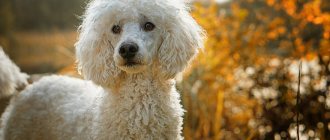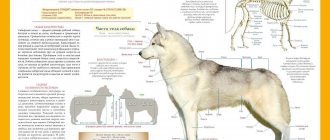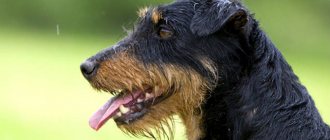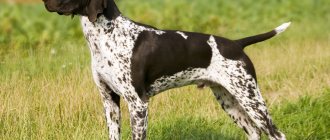Saint Bernard is a calm, non-aggressive and faithful four-legged companion, a nanny for children, a brave rescuer, and an actor beloved by many directors. In films, individuals of this breed are smart, insightful, and friendly. Knowledge of the peculiarities and nuances of upbringing, feeding and training will allow you to prolong the life of your pet and find a true friend.
It is especially important to know the nuances of a dog breed when purchasing puppies. It is from a small individual that you can raise the legendary “alpine rescuer”, instill in him love and vigilance.
Origin story
Early mentions of St. Bernards can be found in the writings of 11th-century Swiss monks. From them it is known that the name of the breed is translated as “Saint Bernard”. The four-legged friends served as rescuers at the monastery and helped search for missing people.
The ancestors of dogs, according to one legend, are the fighting Molossian Great Danes. From them they borrowed character traits - determination, courage, courage. Another legend says that these dogs descended from Tibetan mastiffs. However, one thing is constant in their origin: dogs have guard and search qualities and can be guide dogs.
The most famous representative of the breed is St. Bernard Barry; he has saved at least 40 people. Later, a Foundation was founded in his honor to support the preservation of the purity of the breed.
Description
The breed looks intimidating in appearance due to its large size, but by nature these dogs are sensitive and gentle. They are friendly to people and children and will never cause harm. They are tolerant of animals: cats, dogs, and other pets can easily live in the house with them.
The main characteristics of the breed are intelligence, intelligence, insight, and trainability. From a young age, dogs understand verbal commands and capture the mood of the trainer and owner.
An adult St. Bernard is calm and balanced, despite its menacing appearance. The second feature is often used for domestic needs.
Such a dog is a good watchman and can scare away thieves from the house. She is not characterized by aggressiveness, hostility, or bitterness.
The character of a St. Bernard depends on training and education. From childhood, he needs to instill good qualities, teach the rules of behavior - is it possible to sleep and live in the house, lie on the bed.
Expert opinion
Anna Abramenko
An avid dog lover. Experience in veterinary medicine since 2009.
Ask a Question
The worst thing for a four-legged friend is loneliness. He needs communication with his owner, frequent walks, games, and activities. Without the constant presence of a person, the animal becomes sad, gets sick, and can inflict serious wounds on itself.
Nicknames with meaning
The last selection is names with meaning that will reflect the special characteristics of a pet or pet:
- Agata is good and good-natured. Playful, affectionate, cheerful dog. But the favorite is not devoid of self-esteem - she will never allow herself to be offended.
- Agathon is noble, friendly, benevolent, flexible. A calm, friendly and completely non-aggressive dog who will be the keeper of home comfort.
- Agey – friendly, energetic, joyful. This is a dog who “always has a holiday.”
- Ada is graceful and very beautiful. Easy to train, but remains a proud dog that values personal space.
- Addie is a dog with a “complex character.” But at the same time, he is sensitive, clean and well trained.
- Adela - "noble". An obedient and easy to train dog. Recognizes only a fair and strong owner.
- Aza is a tireless traveler and adventurer.
- Aina is a changeable darling: sometimes quiet and affectionate, sometimes capricious and touchy. Loves to play with children and is friends with pets.
- Alaida is active, playful, but somewhat eccentric and unequal. Pride of owners and decoration of exhibitions.
- Alva is a gambling and restless dog, for whom all life seems like an endless game.
- Alis is nice, calm, understanding. A real family member.
- Alf is the main, first, leader dog. Requires strict but fair education.
- Amanda is a sweet, friendly and attentive dog. Protector of the home and owners.
- Ametis is a proud and reserved “narcissist” dog.
- Cupid is active, temperamental and restless. A dog infinitely devoted to its owner.
- Aretas is a very strong, but not at all aggressive dog. Calm, balanced, loving children.
- Astra is a “two-faced” dog. She can be submissive and stubborn, good-natured and cunning. Smart and highly trainable.
Puppy Alice:
Difference between St. Bernard and Moscow Watchdog
These two breeds have a similar appearance, which will confuse the novice dog owner. They are distinguished by their different origins. Saint Bernard is a descendant of mastiffs who saved travelers lost in the snowy Alps. The Moscow Watchdog is the result of the work of the Soviet nursery "Red Star" to provide security, perform rescue operations and agricultural work. For this purpose, Caucasian Shepherd Dogs, St. Bernards, and Russian Piebald Hounds were crossed.
Interesting article: 10 strongest dog breeds in the world
The second difference is external. The Moscow Watchdog is slightly smaller, with a less broad head.
The difference lies in the characters of the two breeds. Saint Bernard is kind, calm, non-aggressive. The characteristics of the Moscow watchdog depend on its pedigree. If the genes of the Caucasian Shepherd are most pronounced, then one can observe aggressiveness, cruelty, and less learning ability.
The character of a St. Bernard depends 80% on the owner: his upbringing, ability to train, personal qualities of a person (assertiveness, desire, intelligence).
History and breed standard
The direct ancestors of modern St. Bernards can be considered large farm (peasant) dogs that lived in the mountainous regions of the Swiss Alps. These dogs are related either to the Asian Great Danes, for example the ancestors of the Tibetan mastiffs, or to the Roman fighting mastiffs that came to the Alps with the Roman legions.
The name of the St. Bernard breed, in Swiss. St.Bernhardshund, literally translated as “the dog of St. Bernard” and it most likely came from the name of the monastery, which in 1050 (in the 11th century) was founded by a monk from Menton named Bernard (Bernard - in Russian).
The monastery was located on a high mountain pass at an altitude of 2469 (2472) meters above sea level. The main trade route from Central Europe to Northern Italy has been here since the times of the Roman Empire. A mountain shelter was created at the monastery for traveling traders, travelers and pilgrims, which turned out to be very useful. Crossing the pass was difficult and very dangerous due to constant avalanches, strong winds, snowstorms and attacks by robbers. After his death, Monk Bernard was canonized for his such a good deed, and the monastery and orphanage began to be named after him. The pass was also named in honor of Saint Bernard (Bernard) - Great Saint Bernard.
The monks used the ancestors of the St. Bernard at first for protection and protection. Nature itself led the selective selection; generation after generation, only dogs that had the most necessary qualities for living and working in the harsh conditions of the Alpine mountains were left for breeding.
Documentary sources, drawings and records about the monks' dogs, date back to 1695 and 1707. Even then, the ancestors of modern St. Bernards were involved in searching and rescuing people buried in an avalanche. Their exceptional sense of smell and endurance, strength and determination, made it possible to quickly find buried people, dig them up and bring them to a shelter or monastery. Until the opening of the road tunnel under the dangerous pass in 1964, the St. Bernards saved more than 2,000 people. And this is only documented data.
St. Bernards acquired their modern appearance, as a matter of fact, and the first standard of the breed, only at the end of the 19th century; before that they were less massive and more agile. In 1867, breeder Heinrich Schumacher from Holigen, near Bern, began to issue the first geological documents to his St. Bernards. In 1884, the first Swiss St. Bernard club appeared in Basel, and in 1887 the first breed standard was approved.
In Russia, the first St. Bernards appeared in the 80s of the 19th century. After the Great Patriotic War, on the basis of St. Bernards and Caucasian Shepherd Dogs, a new Soviet breed, the Moscow Watchdog, was bred in the famous Krasnaya Zvezda kennel. The National St. Bernard Club was created only in 1996.
According to the ICF classification, St. Bernards belong to group 2: Pinscher, Schnauzer, Molosser and Swiss Cattle Dogs, section 2: Molosser, subsection 2: Mountain type, standard No. 61. There are no performance tests.
Characteristics and standards
The dog of this breed is well built: the body is powerful and proportional, muscle mass and power are pronounced. Average life expectancy is up to 10 years. According to the international standard, she has a large head with drooping triangular-shaped ears, a straight back, and a long tail that does not have any creases.
The weight of an adult dog can reach from 80 to 100 kg. At the same time, the height at the withers for females is 65-80 cm, for males - 70-90 cm. The standard color is considered to be predominantly white with multi-colored markings. Sometimes there are St. Bernards with a small splash of black. But this is not a drawback or a reason for culling.
When breeding, special attention is paid to the character of the individual. A dog of this breed should be friendly, friendly and kind. At the slightest level of cowardice and aggression, individuals are not allowed to participate in exhibitions.
With regular exercise and training, St. Bernards are highly trainable. After completing the course, they make excellent watchdogs, four-legged friends devoted to their owner, ideal neighbors for people, children and other animals.
The size of the dog is impressive - comparable to a calf or pony. He needs good upbringing from a young age, proper care, a large living area, walks and proper arrangement.
Character and appearance
The character of the animal is good-natured, calm, balanced. It's not scary to leave him with small children, other pets, or people. If there is insufficient communication with the owner, the dog becomes depressed: it becomes sad, it hurts itself.
Saint Bernards are not characterized by aggressiveness or cruelty. They can even bark only in some cases, when their home is in danger and there are good reasons for this.
Dogs of this breed understand their owner instantly, predict his mood, and do not cause trouble. In all actions there is a desire to please, to receive praise and approval.
Externally, there are 2 types of individuals: short-haired St. Bernards and long-haired ones. They are harmoniously put together:
- big head;
- muscular strong body;
- majestic, even threatening appearance;
- large size and significant growth.
They have a short muzzle with a slightly upturned nose, triangular, slightly rounded drooping ears and expressive, kind eyes.
Advantages and disadvantages
The main advantage of the breed is its character: completely non-aggressive, hardy, patient. It has good watchdog potential, which allows it to be kept in the house for protection.
Individuals are unpretentious in care and nutrition. St. Bernard puppies and larger representatives are distinguished by above average intelligence and easy learning ability.
Basically, by nature, dogs are slow and phlegmatic. However, a completely different temperament may appear from upbringing and genes. The disadvantage of the breed is the need for a large space and mainly outdoor maintenance. The apartment is cramped for the dog.
Other disadvantages of St. Bernards:
- heavy shedding;
- constant drooling;
- food and maintenance require high expenses;
- the need for training, taking a socialization course and mastering the basic rules of behavior in public places;
- hereditary diseases.
Varieties and colors
An important aspect in describing a breed is variety. Long-haired individuals have a thick undercoat and straight, medium hair. Representatives of the breed have fluffy, slightly wavy pants on their hips. The tail is long, without bends.
The second variety of Saint Bernards is short-haired or smooth-haired. They have the same tail, double coat, and abundant undercoat. The coat is smooth, close-lying, not wavy.
The standard color of the breed is white with spots and inclusions of different sizes: yellow-brown, brown with a predominance of red, red. Sometimes black and white color is found.
Description of the breed
Standard of the International Cynological Federation FCI No. 61 dated October 29, 2003 “St. Bernard." Group 2 “Pinchers and Schnauzers, Molossians, Mountain and Swiss Cattle Dogs.” Section 2 “Molossians”.
Limitations on height at the withers: 70-90 cm for a male, 65-80 cm for a female. Dogs whose height exceeds the maximum are not punished if the excess does not violate the proportions of the structure and the correctness of movements.
There is no official weight limit.
A description of the St. Bernard's appearance according to the official standard is given in the table.
| HEAD | Powerful, impressive and very expressive. |
| EYES | Medium size, dark brown to nut color. Set moderately deep, the expression of the eyes is friendly and welcoming. |
| EARS | Medium size, set high and wide, with highly developed cartilage, soft, triangular in shape with rounded ends. The front edge of the ears fits close to the cheekbones, while the back edge is slightly raised. |
| TEETH | The jaws are strong, wide, and equal in length. The bite is complete, regular, well developed: scissor or pincer-shaped. |
| NECK | Strong and of sufficient length. |
| BREAST | Moderately deep, with well sprung ribs, but not barrel-shaped. Should not fall below elbow level. |
| PAWS | Wide, with strong, dense, well arched toes. Dewclaws are allowed provided they do not interfere with the dog's movement. |
| TAIL | At the base it is wide and thick, long, heavy. In a calm state, the tail is lowered down or may curl slightly upward in the last third; in an alert state, it is raised higher. |
| WOOL | There are two types: short-haired and long-haired. |
| COLOR | The main coat is white with larger or smaller reddish-brown markings (coat with small spots). On the back and sides, the presence of a solid or “torn” reddish-brown “cloak” is welcome, and on the head – the presence of a dark color. We accept red color with brindle and brownish-yellow colors. Small patches of black on the dog's body are not considered a defect. |
Short-haired Saint Bernards have a double coat: the guard hair is dense, smooth, close-lying, and coarse. The undercoat is abundant. There are small fringes on the thighs. The tail is covered with dense, fluffy thick hair.
The long-haired variety has guard hair of medium length, straight, and abundant undercoat. The hair on the face and ears is short; above the hip joints and on the croup usually slightly wavy; there are feathers on the forelimbs, well-defined trousers on the hips. The tail is fluffy.
Externally, St. Bernards are very similar to the Moscow Guard breed.
Maintenance and care
A prerequisite for the breed is the presence of a large, free territory, mainly in its home. The apartment for such a dog is cramped and uncomfortable.
The best option is to organize an enclosure and equip the booth well. The pet needs safety: to do this, you need to remove objects from the access area that can hurt or chew, and cover the slippery floor. It is not necessary to maintain a certain temperature regime for the St. Bernard, since this breed of dog is northern and is not afraid of frost and snow. In the summer, they need to be protected - overheating and heat stroke are possible.
There is no need for special walking for dogs kept in the house. The St. Bernard needs fresh air, limited exercise, and regular socialization. After walks, it is advisable to inspect the paw pads, if there are wounds, treat them, and remove stuck foreign objects.
Grooming your dog should include weekly cleaning of the ears with cotton balls. The vulnerable spot is the eyes, which are prone to inflammation. It is important to wipe them with a clean gauze cloth after each walk and remove mucous secretions.
The disadvantage of the breed is heavy shedding and a large amount of wool. To soften it, it is recommended to use special combs and brushes for combing every day, to prevent the appearance of “tangles”. A healthy four-legged pet should not have an unpleasant, foul smell coming from its fur. If it appears, it is necessary to check its health status, analyze its nutrition, and examine its skin and coat for signs of illness.
Vaccination of the breed is important: the first vaccination is given at 2 months. Then again every quarter, six months and year. If you have illnesses or feel unwell, the veterinarian makes a medical referral. Before vaccination, treatment against worms is required 2 weeks before vaccination. For each representative of the breed, it is better to draw up a schedule with a specialist.
Breed characteristics and character traits
These dogs are most often taken as companions or guards. No one has canceled their vocation as mountain rescuers, but most often St. Bernards are taken to keep families at home. These animals are naturally non-aggressive, patient and adore small children, so they are perfect as a caring nanny.
Due to their even and somewhat phlegmatic nature, these animals get along well with other pets and do not suffer from sudden mood swings, although they can be somewhat stubborn. Saint Bernards are good both as companions for single people and as a pet for the whole family. They also subtly sense the mood of people, so they will definitely support the owner if he is sad.
- I miss!..
Representatives of the St. Bernard dog breed do not tolerate drill during training and long absence of their owners. A dog can even become depressed due to prolonged loneliness or if it is not given due attention.
Education and training
Saint Bernards are smart, quick-witted, and amenable to training. It is important to choose the right methods for this, taking into account the characteristics of the breed, their slowness, and the desire to please the owner.
At home, when training a St. Bernard, it is important to build a respectful, trusting relationship with the dog, to exclude violence and cruelty for disobedience. The puppy must be accustomed to the toilet and its name from the first days of its arrival in the house.
The Saint Bernard is a friendly, slightly touchy, depressed breed. This dog should not be kept on a chain, left alone for a long time, or violence should be used against it. Such measures will cause her apathy and disappointment in the owner.
You need to walk your dog for 2-4 hours, depending on age, during the daytime and in the evening, with the exception of summer with sultry heat. She not only needs to breathe air, but also actively play, run, walk, and follow commands.
When buying a puppy, it is important from the very first day to accustom him to a place to sleep, eat, and basic commands. If the dog has done everything correctly, reward him with treats and affection. When training experience is not enough, it is advisable to undergo training from a professional dog handler.
How much does it cost and how to choose a puppy?
The cost of St. Bernard puppies, like any other breed, depends on many factors. Of course, purebred individuals are more expensive - from 15 to 50 thousand rubles, depending on gender, size and the presence of qualities valued at exhibitions. You can buy a puppy from your own hands for much less, but the risk is higher.
When purchasing a potential family member, do not hesitate to ask previous owners about his parents, their illnesses, and take a copy of their pedigree. Check that all vaccinations have been completed - these should be noted in the puppy’s veterinary passport. The furry baby himself should be strong, with a well-developed head, dense and thick shiny fur, and his paws should not be deformed.
Nutrition
Proper feeding is the key to your pet’s health. Overeating and hunger are not allowed. In the first case, the load on the skeleton and joints increases, excess weight is gained, and the functioning of many body systems in the dog worsens. If she is malnourished, she will not receive the necessary elements, which will lead to weakened immunity and more shedding of fur.
Expert opinion
Anna Abramenko
An avid dog lover. Experience in veterinary medicine since 2009.
Ask a Question
The diet of an adult St. Bernard or puppy should include meat, offal, cereals, vegetables, seafood, and dairy products.
Table of main nutrition components:
It is very important to get clean water into your body. Sweets are not allowed. During the period of active growth, calcium should prevail in the diet in large dosages (cottage cheese, kefir, dairy products).
The frequency of St. Bernard's feeding depends on its mobility, age, and time of year. Puppies are fed 5-6 times a day for up to six months, then until 9 months the number of meals is reduced to 3. Then the adult schedule is followed - twice a day, in the summer - only in the evening.
The quality of nutrition affects the life expectancy, appearance of the dog, its integument, teeth, and organs. A healthy, shiny coat is an indicator of health and proper nutrition.
Keeping and raising a St. Bernard
Considering the size of the St. Bernard, the best option for keeping it would be a private house with an adjacent territory. His soul and body will be cramped in the apartment, and he can only compensate for the lack of freedom with long walks (up to 4 hours a day). Another disadvantage of living in an apartment: due to excessive salivation, especially in hot weather, there will always be wet spots on furniture, flooring, and personal belongings of household members.
In a fenced yard, the pet does not need to be kept on a leash, because it is indifferent to other dogs and cats and does not rush at strangers who enter its territory. However, if the dog believes that family members are in danger, he will immediately rush to protect them. Long-haired individuals can live all year round in an enclosure with a warm booth and an awning from the sun (heat and overheating are dangerous for them). For short-haired pets, it is necessary to provide a place in a heated room during severe frosts.
The lifespan of a St. Bernard largely depends on the conditions of its maintenance: yard pets have better health and live longer than apartment pets.
Considering the weight of an adult St. Bernard, the dog should be taken for a walk wearing a collar and on a strong 2-3-meter leash. Puppies are walked on a leather harness.
Excessive motor activity of puppies while walking, going down and up stairs can lead to pathological changes in the musculoskeletal system. Therefore, in the first months, indoor puppies need to be carried outside in your arms and limited to running.
Care
The lion's share of the St. Bernard's hygiene time is grooming. You need to comb it once every 2 days. In addition, dogs shed twice a year (yard pets are especially profuse), and a long-toothed brush must be used daily. Animals with short hair are combed only during the molting period.
Bathing with shampoos and conditioners is required 2-3 times a year. It is timed to coincide with molting. Dry the “fur coat” immediately. After swimming in a pond, the wool is washed with tap water. There is no need to dry the external auditory canal after water procedures, because it is closed by the ears, but dirt is removed weekly.
Eyes often become inflamed due to dust getting into them, so they are wiped daily with cloth napkins (not cotton wool). The muzzle requires daily care: after eating, it is washed with water or wiped with a piece of cloth. Napkins and diapers are necessary things for the St. Bernard, a dog with hypertrophied drooling.
Paw care involves trimming the nails and hair between the toes. Dry and rough skin of the paw pads is lubricated with nutrients.
Training
From 2-3 months, puppies are taught commands and accustomed to a leash and muzzle. You cannot delay training St. Bernards, because all skills and abilities are developed in the first 2 years of their life.
During the training process, gentle giants demonstrate intelligence, but they lack agility due to their phlegmatic nature. Shouting and punishment will not achieve speed of execution of commands.
The most difficult thing for dogs to do is retrieve, so more attention must be paid to the execution of this command.
Nutrition
St. Bernards are not picky when it comes to food, but they need high-quality nutrition - their health and life expectancy depend on it. An adult dog needs 400-500 g of meat per day (a puppy – 150-200 g). It can be partially replaced with boiled offal.
Once a week they give sea fish, not forgetting seafood. River fish must first be subjected to heat treatment. The rest of the diet consists of vegetables, cereals (rice, buckwheat, barley), vegetables, and dairy products.
Black bread (once a week), butter, and eggs are given in limited quantities. It is prohibited to feed potatoes and legumes, pickles, spicy and smoked foods, and sweets.
Saint Bernards will not refuse a treat, so before offering a treat to your pet, you need to remember that the breed is prone to obesity. Excess weight puts additional stress on the musculoskeletal system and worsens bone health. An addition to the portion is given if after lunch the animal actively licks the feeder.
If feeding dry food, a variety designed for large breeds should be given. A pet eats about 1 kg of granules per day.
Diseases and life expectancy
On average, dogs of this breed live 8-9 years. To improve its quality, it is necessary to follow the vaccination schedule, regularly administer anti-worm medications, and treat in a timely manner.
Saint Bernards are prone to the following diseases:
- joint injuries, knee dislocation, dysplasia;
- epilepsy;
- lymphosarcoma;
- bloating;
- pathological conditions of the organs of vision (entropion or inversion of the eyelid, cataract).
The breed is also prone to obesity and excess weight. They lead to laziness and create additional stress on the digestive organs, heart, blood vessels, and joints. Prevention requires proper nutrition, a healthy diet, and moderate regular physical activity.
Interesting facts about St. Bernards
- It is impossible to name the exact ancestor of the breed; there is a lot of disagreement on this matter. Cynologists argue to this day where the St. Bernard breed came from. It is known that the country of origin is Switzerland, but no one knows for sure which breeds were selected for selection. According to experienced dog handlers, the ancestor of the big red-and-white dogs was the Tibetan Great Dane. There is also an opinion that to breed St. Bernards, mastiffs and Great Danes were crossed.
- A special feature of St. Bernard training is the ability to work in pairs. They went in search of a person, then dug him out of the snow, after which the female remained to warm the frozen one, and the male went to people for help.
- The breed was named after the monastery of St. Bernard, located in the Alps.
- The dog breed is often found in cartoons and movies, and in leading roles. St. Bernards gained particular popularity because of the film “Genevieve,” as well as the TV series “Hopper,” and of course, who doesn’t remember the movie “Beethoven.”
- There were always dogs of this breed in the monastery, because they constantly helped to rescue people caught in a snow blockage or an avalanche. Only rough estimates indicate more than several thousand saved.
- A documented case where St. Bernard Barry helped 40 people who were captured by the elements. These were isolated cases recorded between 1800 and 1812. The dog helped them find their way to the monastery without freezing or getting lost. There was also a case when Barry carried a boy on his back for 5 km. He found the child in the snow and independently decided to take him to the people. Since that time, the most beautiful and strong puppy from the litter receives the nickname Barry. The dog rightfully deserved a monument that grateful people erected to him.
- From cartoons and movies, you can see that St. Bernards must have a barrel on their neck. There is constant controversy surrounding this “accessory”. According to the legend, brandy was poured into the container so that a person dug out from under the snow could warm up and find the strength to reach the shelter. True, it is much more prosaic, because the barrel is the fiction of Edwin Landseer. The artist painted canvases with alpine landscapes and handsome St. Bernards, and a small barrel became their highlight.
- However, today, St. Bernards do not go to work empty-handed. Not with a keg, of course, but with a modern first aid kit and a small supply of provisions and water.
- Huge and at first glance scary St. Bernards, but in fact not at all aggressive. In the “kindest breed” category, they can easily count on a prize. Aggression on the part of a St. Bernard is a very rare occurrence.
- Due to the characteristics of the breed, they grow very quickly, but remain playful like a puppy long after they grow up. Even a very large dog can behave “like a child.”
- A significant disadvantage of the breed is its short life expectancy compared to other breeds. Even with excellent care and good health, St. Bernards rarely live to the age of 9-11 years.
- If you need a versatile dog, then the St. Bernard will be the ideal choice. He can become an assistant, a friend and a good listener. The Saint Bernard will reliably protect the house, and if necessary, can save the life of its owner.
If you decide to get a dog, then get ready for the following: you will often have to clean up little mistakes after your puppy; investments will be required in annual vaccinations, feeding, toys, ammunition, etc.; any animal requires attention and communication, so if you don’t have time, then there will be no mutual understanding with the St. Bernard puppy. Big changes are coming in your life. If you can handle this, you will find a loyal friend for life.
Choosing a puppy
When buying a puppy, you need to study the offers, visit well-known nurseries with a good reputation, and take the help of an experienced expert.
When choosing a dog, it is advisable to determine the purpose for which the animal is purchased - participation in competitions, exhibitions, home security, nanny for children. The cost depends on this.
Expert opinion
Anna Abramenko
An avid dog lover. Experience in veterinary medicine since 2009.
Ask a Question
It is recommended to look at the puppy’s parents – their achievements, health status, external data, size. What the mother and father of the family look like is what the puppy will be like at an older age. It is also advisable to take a closer look at the character of the future pet, its physical health, evenness of limbs, cleanliness of skin and coat.
Reviews
Julia: “Saint Bernard has been living with us for 4 years. This is the most devoted, great friend. He understands everything perfectly, rarely barks and does not bother his neighbors. The only negative is drool and fur. If you comb it regularly, and during the shedding period 2-3 times a day, then the problem is not so much of a concern.”
Ivan: “I love dogs of this breed. The first lived for 8 years, the second is now 10, the third is still a puppy. Their virtues captivated me: they love children, they are loyal, balanced, they do not spoil furniture.”
Oleg: “Our friend St. Bernard looks like a cute, shaggy monster. He is intimidating with just his appearance, protects the house, and does not cause inconvenience with constant barking, like the dogs around the neighborhood. The only negative is the drool that flies onto the floor, sofa, carpet.”
History of the breed
The Saint Bernard dog breed was originally bred to rescue people from avalanches in the mountains. Rumor has it that these born rescuers, thanks to their impeccable sense of smell, can smell a person at a depth of 6 meters under the snow. The structure of their legs and paws helps them remain stable and dig quickly.
The cradle of dogs of this breed is considered a shelter for travelers in the Swiss Alps. It was founded by the monk Bernard in the 11th century (hence the name of the breed: from the French “Saint Bernard” - “Saint Bernard”), and at the beginning of the 18th century dogs became its full-fledged residents.
Born Rescuer
Very soon, local monks discovered in their pets the amazing ability not only to predict avalanches, warning others about it, but also to find unfortunate victims under the thickness of the snow. The Swiss Alps are notorious not only for their low temperatures, but also for frequent avalanches up to 18 m high.
The first St. Bernards were smooth-haired, a trait apparently inherited from the mastiff. However, after a widespread epidemic and numerous deaths of dogs from cold and disease in the 19th century, the monks crossed the breed with the Newfoundland, obtaining thick-haired offspring. Both long-haired and short-haired dogs retained the ability to work as a rescuer.
To this day, this shelter breeds rescue St. Bernards, although modern operations are carried out with the help of aerial technology and German shepherds.
Titanically calm and incredibly strong, these dogs are perfect for mountain rescue missions. In conditions of a headwind, they sense a person at a distance of 3 km and are able to find him under a 4-meter layer of snow. Having found it, the St. Bernard licks the person’s face in order to prevent the latter from falling asleep, and lies on top, warming the victim of the elements with his warmth.
Photo and video review
You can estimate how much an adult weighs, what it looks like, and how it differs from other dogs in photos and videos.
This is the kindest breed, loving its owner and finding a common language with small children. A Saint Bernard with a person is an excellent connection, where respect and mutual understanding reign. Aggressiveness and manifestations of bitterness are unusual for him.
Knowing all the characteristics of a dog, following the basics of education, training, and care will allow you to find a faithful, four-legged friend and prolong the life of your pet. The usual duration is 8-9 years.











